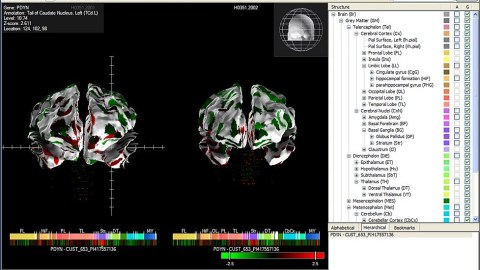Navigating a New Age of Discovery for the Human Brain

With the launch of the Allen Human Brain Atlas – the first-ever 3D, interactive atlas of the anatomy and genes that comprise the human brain – is it possible that we’ve just entered a radically new Age of Discovery? Rather than discovering the unimagined riches of new continents, we may be on the cusp of unlocking the full potential of the human brain. Just as the first maps and atlases of the New World nearly five hundred years ago launched a golden Age of Discovery that led to the Renaissance and the Modern Age, the Allen Human Brain Atlas could launch a similar type of neuro-scientific Renaissance that finally decodes the mysteries within our minds.
As the scientists at the Allen Institute for Brain Science point out, the Human Brain Atlas is essentially a GPS for the brain, enabling neuro-researchers to locate the exact locations where human genes are expressed: “For the first time, we have generated a comprehensive map of the brain that includes the underlying biochemistry.” Already, there has been a stunning revelation – that any two human brains are 94% alike. Without being a trained neuroscientist, it’s hard to dispute this claim, but it leads to some interesting back-of-the-envelope calculations. Let’s see – if we only use 2% of our brains (as our elementary school teachers told us), and if 94% of our brains are already identical across gender, race and ethnicity, then it really means that a tiny – almost infinitesimal – difference in brain power accounts for the true geniuses of the world. Imagine what might be possible by altering just a tiny fraction of our brain’s real estate.
What’s truly amazing is that the entire mapping of the human brain came largely out of the vision of a Microsoft multi-multi-billionaire, Paul Allen — the same Paul Allen who’s launched extraordinary initiatives in areas ranging from space exploration to biotechnology. (Oh, and did I mention, he also owns two professional sports teams?) With his $55 million computerized atlas, Allen is essentially throwing open the Human Brain to thousands of researchers around the world. In IT-speak, he’s opened up the brain API and told researchers across the globe, “Have at it, go develop your brain apps, it’s free!”
It will be fascinating to see what neuroscientists and brain surgeons do with this human brain atlas. For a preview of what may lay ahead, it’s worth re-visiting Carl Zimmer‘s fascinating book Soul Made Flesh: The Discovery of the Brain – And How It Changed the World, in which he recounts how we shifted to a new brain-centric view of humanity. The hero of his work was Thomas Willis, a British doctor and neurologist who played a pivotal role in changing our perceptions of the human brain. By observing the brain in physical form, Western doctors were finally able to deduce the role that the brain played in everything from reason to irrational emotion. In much the same way, Paul Allen may be this century’s Thomas Willis, spurring global researchers to engage on a spirited – and perhaps spiritual – discovery of what’s inside our minds.
Certainly, the human brain never ceases to be an object of wonderment for young and old alike. (If you’re living in or visiting New York City, there’s still time to check out the American Museum of Natural History’s Brain: The Inside Story exhibit!) By having an atlas for understanding exactly where, how and why the brain acts, we may now be years – not decades – away from solving the worst ailments of the brain, including Alzheimer’s, autism and depression. Imagine having a GPS navigator able to take us anywhere we want in the human brain. The only question, perhaps, is how far we will enable ourselves to go: Are we simply harnessing the wonderful power of nature, or are we, instead, playing God with our brains?





